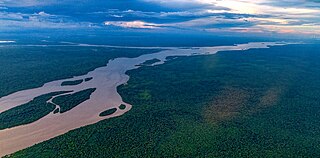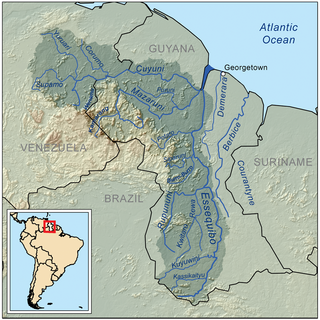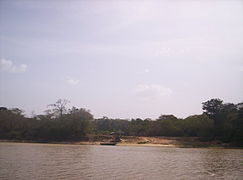
British Guiana was a British colony, part of the mainland British West Indies, which resides on the northern coast of South America. Since 1966 it has been known as the independent nation of Guyana.

The Essequibo River is the largest river in Guyana, and the largest river between the Orinoco and Amazon. Rising in the Acarai Mountains near the Brazil–Guyana border, the Essequibo flows to the north for 1,014 km (630 mi) through forest and savanna into the Atlantic Ocean. It has a total drainage basin of 156,828 km2 (60,552 sq mi) and an average discharge of 5,650 m3/s (200,000 cu ft/s).

Barima-Waini is a region of Guyana and is located in the northwest of the country. Barima-Waini has three sub-regions: Mabaruma, Matakai, and Moruca.

The Guianas, also spelled Guyanas or Guayanas, is a region in north-eastern South America. Strictly, the term refers to the three Guyanas: Guyana, Suriname and French Guiana, formerly British, Dutch and French Guyana. Broadly it refers to the South American coast from the mouth of the Oronoco to the mouth of the Amazon.

The Cuyuni River is a South American river and a tributary of the Essequibo River. It rises in the Guiana Highlands of Venezuela, where it descends northward to El Dorado, and turns eastward to meander through the tropical rain forests of the Cuyuni-Mazaruni Region of Guyana. It finally turns southeastward, flowing to its confluence with the Mazaruni River.

Cuyuni-Mazaruni is a region of Guyana. Its capital is Bartica, with villages including Issano, Kartabo, Kamarang, and Imbaimadai.

Pomeroon-Supenaam is a region of Guyana. It borders the Atlantic Ocean to the north, the region of Essequibo Islands-West Demerara to the east, the region of Cuyuni-Mazaruni to the south and the region of Barima-Waini to the west. Pomeroon-Supenaam contains the town of Anna Regina and the villages of Charity, Pickersgill, Spring Garden and Suddie. In 2012, an Official Census by the Government of Guyana listed the population of the Pomeroon-Supenaam Region at 46,810.

Potaro-Siparuni is a region of Guyana. It borders the region of Cuyuni-Mazaruni to the north, the regions of Upper Demerara-Berbice and East Berbice-Corentyne to the east, the region of Upper Takutu-Upper Essequibo to the south and Brazil to the west.

Essequibo was a Dutch colony in the Guianas and later a county on the Essequibo River in the Guiana region on the north coast of South America. It was a colony of the Dutch West India Company between 1616 and 1792 and a colony of the Dutch state from 1792 until 1815. It was merged with Demerara in 1812 by the British who took control. It formally became a British colony in 1815 until Demerara-Essequibo was merged with Berbice to form the colony of British Guiana in 1831. In 1838, it became a county of British Guiana till 1958. In 1966, British Guiana gained independence as Guyana and in 1970 it became a republic as the Co-operative Republic of Guyana. It was located around the lower course of the Essequibo River.

The Rupununi uprising was a secessionist insurrection in Guyana that began on 2 January 1969 led by cattle ranchers who sought to control 22,300 square miles (58,000 km2) of land. Occurring less than two years after Guyana’s independence from the United Kingdom, it constituted the country’s earliest and most severe test of statehood and social solidarity. The rebels were ultimately dispersed by the Guyana Defence Force, with the group's leaders fleeing to Venezuela.

The Schomburgk Line is the name given to a survey line that figured in a 19th-century territorial dispute between Venezuela and British Guiana. The line was named after German-born English explorer and naturalist Robert Hermann Schomburgk (1804–1865). The dispute arose because when the United Kingdom acquired British Guiana from the Netherlands in 1814, the western border with Venezuela was not defined.

The Guyana–Venezuela territorial dispute is an ongoing territorial dispute between Guyana and Venezuela over the Essequibo region, also known as Esequibo or Guayana Esequiba in Spanish, a 159,500 km2 (61,600 sq mi) area west of the Essequibo River. The territory, excluding the Venezuelan-controlled Ankoko Island, is controlled by Guyana as part of six of its regions, based on the 1899 Paris Arbitral Award. It is also claimed by Venezuela as the Guayana Esequiba State. The boundary dispute was inherited from the colonial powers and has persisted following the independence of Venezuela and Guyana.

Guyana, officially the Co-operative Republic of Guyana, is a country on the northern coast of South America, part of the historic mainland British West Indies. Guyana is an indigenous word which means "Land of Many Waters". Georgetown is the capital of Guyana with the largest population. Guyana is bordered by the Atlantic Ocean to the north, Brazil to the south and southwest, Venezuela to the west, and Suriname to the east. With a land area of 214,969 km2 (83,000 sq mi), Guyana is the third-smallest sovereign state by area in mainland South America after Uruguay and Suriname, and is the second-least populous sovereign state in South America after Suriname; it is also one of the least densely populated countries on Earth. It has a wide variety of natural habitats and very high biodiversity. The country also hosts one part of the Amazon rainforest, the largest tropical rainforest in the world.

Guyana–Venezuela relations include diplomatic, economic and other interactions between the neighboring countries of the Co-operative Republic of Guyana and the Bolivarian Republic of Venezuela.

The Venezuelan crisis of 1895 occurred over Venezuela's longstanding dispute with Great Britain about the territory of Essequibo and Guayana Esequiba, which Britain claimed as part of British Guiana and Venezuela saw as Venezuelan territory. As the dispute became a crisis, the key issue became Britain's refusal to include in the proposed international arbitration the territory east of the "Schomburgk Line", which a surveyor had drawn half-a-century earlier as a boundary between Venezuela and the former Dutch territory ceded by the Dutch in the Anglo-Dutch Treaty of 1814, later part of British Guiana. The crisis ultimately saw Britain accept the United States' intervention in the dispute to force arbitration of the entire disputed territory, and tacitly accept the US right to intervene under the Monroe Doctrine. A tribunal convened in Paris in 1898 to decide the matter, and in 1899 awarded the bulk of the disputed territory to British Guiana.

The Tigri Area is a wooded area that has been disputed by Guyana and Suriname since around 1840. It involves the area between the Upper Corentyne River, the Coeroeni River, and the Kutari River. This triangular area is known as the New River Triangle in Guyana. In 1969 the conflict ran high on, and since then it has been controlled by Guyana and claimed by Suriname. In 1971, both governments agreed that they would continue talks over the border issue and withdraw their military forces from the disputed triangle. Guyana has never held upon this agreement.

The Agreement to resolve the conflict between Venezuela and the United Kingdom of Great Britain and Northern Ireland over the border between Venezuela and British Guiana, better known as the Geneva Agreement, is a treaty between Venezuela and the United Kingdom, along with its colony of British Guiana, that was signed in Geneva, Switzerland, on 17 February 1966. The treaty outlines the steps taken to resolve the territorial dispute between Venezuela and the United Kingdom over the region of Guayana Esequiba, arising from Venezuela's contention to the UN in 1962 that the 1899 declaration by the Paris Tribunal of Arbitration awarding the territory to British Guiana was null and void, following the publication of Severo Mallet-Prevost's memorandums and other documents from the tribunal that called the decision into question.

A consultative referendum was initiated by the government of Nicolás Maduro regarding Venezuela's claim over the Guayana Esequiba, whose territory is disputed with, and controlled by, neighboring Guyana. The referendum took place on 3 December 2023 in Venezuela. The population of the territory in question was not consulted and did not vote as voting only took place within Venezuela.

The long-standing territorial dispute over the Essequibo region escalated into a crisis in 2023. The region is controlled by Guyana but is claimed by Venezuela. The dispute dates back many years and the current border was established by the Paris Arbitral Award in 1899. Venezuela renewed its claim in 1962 and the matter was referred to the International Court of Justice (ICJ) in 2018.

The Protocol to the Agreement to resolve the controversy between Venezuela and the United Kingdom of Great Britain and Northern Ireland over the frontier between Venezuela and British Guiana, simply known as the Port of Spain Protocol, is a protocol of the 1966 Geneva Agreement between Guyana and Venezuela and a 12-year moratorium on Venezuela's reclamation of Guayana Esequiba.


















